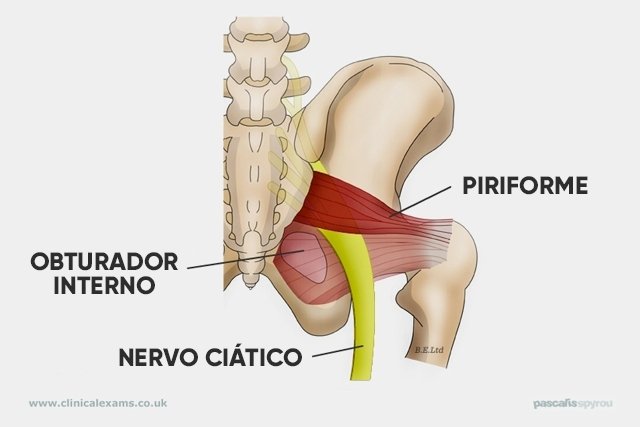Piriformis syndrome is a rare condition which is characterized by the sciatic nerve abnormally passing through the fibers of the piriformis muscle, found in the buttock. This anatomical location causes sciatic nerve inflammation due to constant compression from the muscle.
People with piriformis syndrome that are experiencing sciatic nerve inflammation will often have symptoms like intense pain that radiated down the right leg (which is the side that is most affected) as well as pain in the buttock, numbness and a burning sensation.
To diagnose piriformis syndrome, the physiotherapist or doctor will usually perform some tests to rule out other conditions and assess the severity. This will help to determine the most appropriate treatment approach.

Common symptoms
The symptoms that occur with piriformis syndrome are related to compression of the sciatic nerve by the piriformis muscle. These symptoms are usually noticed in the lower back, glutes and thighs and may include:
- Stinging pain
- Burning or tingling sensation in the buttocks or behind the thigh
- Pain in the lateral region of the leg and the top of the foot
- Worsening pain when sitting and crossing legs
- A first flare-up that occurs during pregnancy, due to the increase in weight and belly size
- Walking with a limp during a flare-up
- Leg weakness or a feeling of numbness in the buttock or leg
Some situations that may favor piriformis syndrome include enlargement of the piriformis muscle from training glutes in the gym, gluteal contracture, falling while sitting, a car accident, or any direct blow to the buttocks region that causes a bruise and sciatic nerve compression.
Also recommended: Sciatica: What Is It & How to Relieve (with symptoms quiz) tuasaude.com/en/sciaticaDiagnostic tests
To diagnosis piriformis syndrome, the doctor or physiotherapist can perform some tests, such as:
- Freiberg test, in which the person is placed face down, the knees are flexed with heels facing up and the doctor or physiotherapist passively performs an internal rotation of the hip to check for pain. If there is pain, the test is said to be positive for piriformis syndrome;
- FAIR test, which is also known as the combined flexion, adduction and internal rotation test, and consists of placing the person lying on their side and flexing the leg at the knee at a 90º flexion, the adducting and internally rotationg the knee. During the test, if there is pain when performing any movement, the FAIR test is said to be positive;
- Lasègue test, in which the person is placed face up and raising the legs up to 70º with the aim of flexing the hips to stretch the nerve branches of the the sciatic nerve. If pain is felt, the test is said to be positive and may be indicative of piriformis syndrome or a herniated disc, and it is important to carry out further testing;
- Beatty test, in which the person is placed on their side and the doctor flexes the top leg at the knee and brings that top knee to touch the bed or floor in front of the bottom leg. If there is pain, the test is said to be positive;
- Pace test, which is done with the person sitting and the person is asked to abduct the legs, which consists of moving the knees apart. If pain is felt in the glutes when performing this movement, the test is considered positive.
The results of these tests can help to confirm suspicions piriformis syndrome or rule out other conditions that present with similar symptoms. The doctor can opt to order further tests and then move on to initiating the most appropriate treatment plan.
Also recommended: Glute Pain: 8 Common Causes & What to Do tuasaude.com/en/glute-painTreatment options
It is not possible to surgically correct the sciatic nerve's path because the surgery creates large scars in the buttock which can lead to even more symptoms. In this case, whenever a person experiences sciatic pain, treatment should be aimed at stretch and reduce tension in the piriformis muscle.
Physiotherapy sessions are a great treatment option to reduce pain and discomfort, and are generally very effective. Your doctor may also recommend the following interentions:
- Deep massage, which can be done by sitting in a chair and placing a tennis or ping-pong ball underneath the affected buttock and then using your body weight to move the ball side to side and also back and forth;
- Stretching two to three times a day, every day. Check out some sciatica stretches you can perform at home.
- Myofascial release technique, which may include deep massage. This can cause some pain and discomfort, but also brings great relief from symptoms in the following days;
- Warm water bottle on the area of pain to relieve muscle tension around the nerve.
If symptoms do not improve with these interventions or if pain is very severe, the doctor may prescribe oral medications, like ibuprofen or naproxen, or IM injections, like anesthetics and corticosteroids. Read more about the sciatica medication that your doctor may prescribe.
Also recommended: Sciatica Pain Relief: Medication, Stretches, Sleep Position & More tuasaude.com/en/sciatica-pain-reliefRecovery time
Recovery time may vary from one person to another and also depends on the treatment carried out. However, in most cases, relief can be seen within 1-3 weeks after starting physiotherapy.
However, even after treatment, it is possible that the pain returns from time to time, especially in those who do not stretch regularly.
